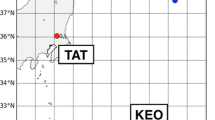Abstract
In recent studies (Spencer and Christy, 1990; and Spenceret al., 1990) it is suggested that observations at 53.74 GHz made by the Microwave Sounding Unit (MSU), flown on NOAA operational weather satellites, can yield a precise estimate of global mean temperature and its change as a function of time. Hansen and Wilson (1993) question their interpretation of temporal changes on the grounds that the microwave observations could be influenced by the opacity of the variable constituents in the atmosphere. This issue has broad interest because of the importance of detection of global climatic change.
In order to help resolve this issue, in this study we utilize a radiative transfer model to simulate: (a) the observations of MSU Channel 1 (Ch. 1) at 50.3 GHz, in the weakly absorbing region of the 60 GHz molecular oxygen absorption band; and (b) the observations of MSU Channel 2 (Ch. 2) at 53.74 GHz, in the moderately strong absorption region of the same band. This radiative transfer model includes extinction due to clouds and rain in addition to absorption due to molecular oxygen and water vapor.
The model simulations show that, over the oceans, extinction due to rain and clouds in Ch. 1 causes an increase in brightness temperature, while in Ch. 2 it causes a decrease. Over the land, however, both Ch. 1 and Ch. 2 show a decrease in brightness temperature due to rain and cloud extinction. These theoretical results are consistent with simultaneous observations in Ch. 1 and Ch. 2 made by MSU. Based on theory and observations we infer that a substantial number of the MSU observations at 53.74 GHz used by Spenceret al. contain rain and cloud contamination. As a result, their MSU derived global mean temperatures and long term trend is questionable.
Similar content being viewed by others
References
Chandrasekhar, S.: 1960,Radiative Transfer, New York, Dover, Inc.
Chang, A. T. C. and Wilheit, T. T.: 1979, ‘Remote Sensing of Atmospheric Water Vapor, Liquid Water, and Wind Speed at the Ocean Surface by Passive Microwave Techniques from Nimbus 5 Satellite’,Radio Sci. 14, 793–803.
Dorman, C. E. and Bourke, R. H.: 1979, ‘Precipitation over the Pacific Ocean, 30° S to 60° N’,Mon. Wea. Rev. 107, 896–910.
Hansen, J. and Wilson, H.: 1993, ‘Commentary on the Significance of Global Temperature Records’,Clim. Change 25, 185–191.
Hinton, B. B., Olson, W. S., Martin, D. W., and Auvine, B.: 1992, ‘A Passive Microwave Algorithm for Tropical Oceanic Rainfall’,J. Appl. Meteor. 31, 1379–1395.
Liou, K.: 1980,An Introduction to Atmospheric Radiation, Academic Press, 1-392.
Olson, W. S.: 1987,Estimation of Rainfall Rates in Tropical Cyclones by Passive Microwave Radiometry, Ph.D. Thesis, Univ. of Wisconsin-Madison, 282 pp.
Prabhakara, C., Fraser, R. S., Dalu, G., Wu, M.-L. C., Curran, R. J., and Styles, T.: 1988, ‘Thin Cirrus Clouds: Seasonal Distribution over Oceans Deduced from Nimbus-4 IRIS’,J. Appl. Meteor. 27, 379–399.
Savage, R. C.: 1976,The Transfer of Thermal Microwaves through hydrometeors, Ph.D. Thesis, Univ. of Wisconsin-Madison, 147 pp.
Schmugge, T. J.: 1978, ‘Remote Sensing of Soil Moisture’,J. Appl. Meteor. 17, 1549–1557.
Short, D. A. and North, G. R.: 1990, ‘The Beam Filling Error in ESMR-5 Observations of GATE Rainfall’,J. Geophys. Res. 95, 2187–2193.
Spencer, R. W. and Christy, J. R.: 1990, ‘Precise Monitoring of Global Temperature Trends from Satellites’,Science 247, 1558–1562.
Spencer, R. W., Christy, J. R., and Grody, N. C.: 1990, ‘Global Atmospheric Temperature Monitoring with Satellite Microwave Measurements: Method and Results, 1979-1984’,J. Clim. 3, 1111–1128.
Spencer, R. W. and Christy, J. R.: 1992, ‘Precision and Radiosonde Validation of Satellite Gridpoint Temperature Anomalies. Part I: MSU Channel 2’,J. Clim. 5, 847–857.
Wang, J. R. and Schmugge, T. J.: 1980, ‘An Empirical Model for the Complex Dielectric Permittivity of Soils as a Function of Water Content’,IEEE Trans. Geosci. Remote Sensing GE-18, 288–295.
Weinmann, J. A. and Guetter, P. J.: 1977, ‘Determination of Rainfall Distributions from Microwave Radiation Measured by the Nimbus 6 ESMR’,J. Appl. Meteor. 16, 437–442.
Author information
Authors and Affiliations
Rights and permissions
About this article
Cite this article
Prabhakara, C., Nucciarone, J.J. & Yoo, JM. Examination of ‘global atmospheric temperature monitoring with satellite microwave measurements’: 1) theoretical considerations. Climatic Change 30, 349–366 (1995). https://doi.org/10.1007/BF01091931
Received:
Revised:
Issue Date:
DOI: https://doi.org/10.1007/BF01091931




